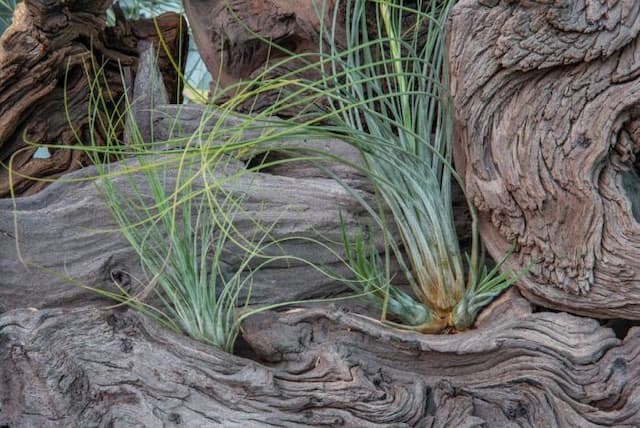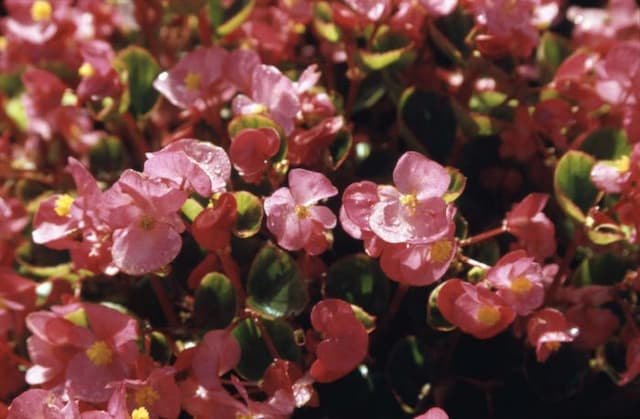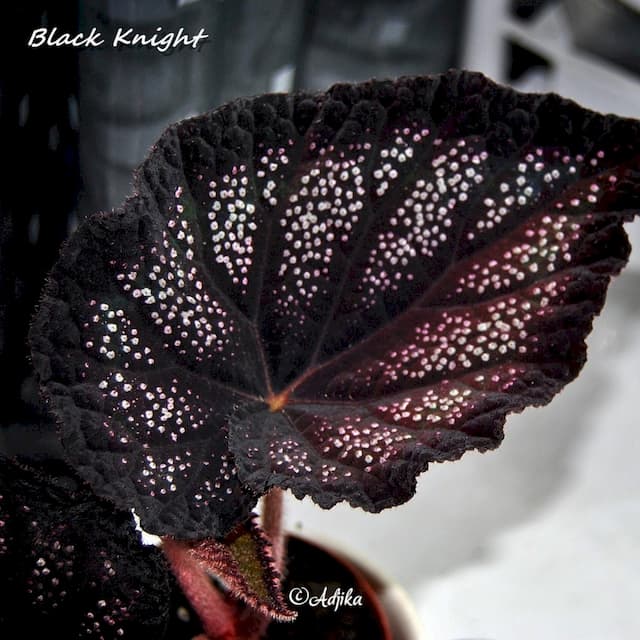Begonia Begonia 'Regal Minuet' (R)

ABOUT
The Begonia 'Regal Minuet' is a striking ornamental plant that is admired for its vibrant and lush foliage. It has a beautiful mounding growth habit, presenting a full and bushy appearance that adds to its allure in any setting. The leaves of this begonia are truly the stars of the show. Each leaf is intricately patterned with a captivating mix of colors. The foliage exhibits a base color of deep green that beautifully offsets the dramatic splashes or streaks of silver or white. The texture of the leaves is also noteworthy; they are thick and fleshy, often with a waxy sheen that reflects light, enhancing their showy coloration. The edges of these begonia leaves are notably distinct, as they are serrated or scalloped, giving each leaf a delicate yet intricate border that further accentuates its shape. Adding to the charm, when the plant blooms, it showcases an exquisite display of delicate flowers. These blossoms can be small but are usually quite noticeable because of their vibrant hues that contrast with or complement the foliage, creating a spectacular visual effect. The 'Regal Minuet' blends both the beauty of its foliage and the allure of its blooms to offer a plant that is both classic in its ornamental value and regal, as its name suggests. It remains a beloved choice for those looking to add a touch of elegance to indoor spaces, gardens, or terrariums, without taking up too much space with its moderate size. With its lush appearance and striking colors, it indeed presents as a botanical minuet — a dance of leaves and flowers in harmonious sophistication.
About this plant
 Names
NamesFamily
Begoniaceae
Synonyms
Regal Minuet Begonia
Common names
Begonia 'Regal Minuet' (R).
 Toxicity
ToxicityTo humans
Begonias, like the Begonia 'Regal Minuet', are considered to be mildly toxic to humans if ingested. The main toxic component is calcium oxalate crystals, which can cause irritation to the mouth, lips, throat, and stomach if eaten. Symptoms of poisoning may include a burning sensation in the affected area, swelling of oral tissues, difficulty swallowing, and in severe cases, vomiting and diarrhea. Care should be taken to avoid consuming any part of the begonia plant.
To pets
Begonias, including the Begonia 'Regal Minuet', are also toxic to pets, specifically cats and dogs. The toxicity arises from insoluble oxalates contained in the plant which can irritate the mouth, tongue, and lips, and cause difficulty swallowing, vomiting, and drooling if ingested. Consistent with the effects in humans, swelling of the oral tissues may also occur in pets. It's important to prevent pets from chewing or ingesting any part of the plant to avoid these adverse reactions.
 Characteristics
CharacteristicsLife cycle
Perennials
Foliage type
Evergreen
Color of leaves
Mixed
Flower color
Pink
Height
1 to 1.5 feet (30 to 45 cm)
Spread
1 to 1.5 feet (30 to 45 cm)
Plant type
Herb
Hardiness zones
10
Native area
Central and South America
Benefits
 General Benefits
General Benefits- Decorative foliage: The Regal Minuet Begonia has attractive leaves with unique patterns that add visual interest to any space.
- Versatile in landscaping: It can be used in a variety of settings, from container gardens to shaded parts of outdoor gardens.
- Easy to care for: Begonias are known for their low maintenance requirements, making them suitable for gardeners of all skill levels.
- Brightens indoor spaces: It can be kept indoors as a houseplant, adding a splash of color to interior environments.
- Compact growth: Its moderate growth habit means it won't outgrow its space quickly and is easy to manage.
- Seasonal blooms: The Regal Minuet Begonia produces lovely flowers that can enhance the plant's decorative appeal during blooming season.
- Attracts pollinators: When planted outdoors, it can attract beneficial insects like bees and butterflies, which are essential for a healthy ecosystem.
 Medical Properties
Medical PropertiesThis plant is not used for medical purposes.
 Air-purifying Qualities
Air-purifying QualitiesThis plant is not specifically known for air purifying qualities.
 Other Uses
Other Uses- Artistic Inspiration: The striking foliage and floral patterns of the Begonia can serve as a muse for artists and designers, who may draw upon its colors and textures for creative work.
- Craft Projects: Begonia leaves and flowers can be used in pressed flower projects or for adding natural elements to homemade greeting cards and scrapbooks.
- Photography Subject: Due to its unique appearance, the Begonia is an excellent subject for photography, especially macro photography that showcases its intricate details.
- Educational Tool: The plant can be used in botany lessons to educate individuals about plant anatomy, hybridization, and plant care.
- Culinary Garnish: While not commonly used and only if known to be safe, the petals of some Begonia varieties can be used to add a colorful garnish to salads and desserts.
- Theme Gardens: Begonias can be part of themed gardens, such as Victorian or tropical themes, where their appearance contributes to the overall aesthetic.
- Fragrance Extraction: If the variety produces a scent, its fragrance can sometimes be used in the production of perfumes or aromatic oils, though this is not a common use for Begonias.
- Seasonal Decorations: The colorful leaves and flowers of Begonias can be incorporated into seasonal decorations, such as autumnal arrangements or spring displays.
- Wedding Decor: Begonias can be part of wedding floral arrangements, bouquets, and table centerpieces due to their vibrant colors and lush appearance.
- Color Dye: Some plants can be used to create natural dyes, and while Begonias are not widely known for this, adventurous crafters might experiment with their petals for fabric or paper dyeing.
Interesting Facts
 Feng Shui
Feng ShuiThe Begonia is not used in Feng Shui practice.
 Zodiac Sign Compitability
Zodiac Sign CompitabilityThe Begonia is not used in astrology practice.
 Plant Symbolism
Plant Symbolism- Caution: Begonias often symbolize a warning to be cautious or to tread carefully in new situations.
- Harmony: The 'Regal Minuet' variety, with its beautiful and balanced appearance, can represent harmony and a balanced approach to life.
- Individuality: With unique patterns and varied foliage, begonias can symbolize individuality and the importance of standing out from the crowd.
- Gratitude: Sometimes, begonias are used to express appreciation and thanks, making them appropriate for giving as a gift of gratitude.
 Water
WaterTo water a Begonia 'Regal Minuet', also known as Rex Begonia, provide a thorough watering to moisten the entire root ball, then allow the top inch of soil to dry out before watering again. On average, watering once a week is a good starting point, but this frequency may need to be adjusted depending on the temperature and humidity of your environment. Use room temperature water to avoid shocking the plant's roots and add approximately 8-16 ounces of water for a standard 6-inch pot. It's critical not to let the plant sit in water, as this can lead to root rot, so ensure any excess is drained away.
 Light
LightRex Begonias prefer bright, indirect light to maintain their vibrant foliage without being exposed to direct sunlight, which can scorch their leaves. The optimal spot for a Rex Begonia would be near an east or north-facing window where it will receive plenty of light without the harsh midday sun. Avoid placing it in an overly shady spot, as this can lead to leggy growth and fewer leaves.
 Temperature
TemperatureRex Begonia thrives in temperatures between 60 to 75 degrees Fahrenheit, preferring a warm and stable environment without sudden drafts or temperature swings. It's crucial to keep the plant away from temperatures below 50 degrees Fahrenheit, as cold conditions can be damaging. The ideal range is comfortably within typical indoor conditions, but keep the plant away from heat sources and cold windows during the winter months.
 Pruning
PruningPrune Rex Begonia to maintain its shape and encourage fuller growth. Remove any dead or damaged leaves using clean shears to prevent the spread of disease. The best time for pruning is in the spring, but you can remove unsightly leaves throughout the year as needed. Regular pruning also helps to improve air circulation around the plant, which is essential for preventing fungal diseases.
 Cleaning
CleaningAs needed
 Soil
SoilThe ideal soil mix for Begonia 'Regal Minuet' should be rich in organic material, well-draining, and slightly acidic to neutral, with a pH ranging from 6.0 to 7.0. A blend consisting of peat moss, perlite, and pine bark is commonly recommended to provide the necessary drainage and aeration.
 Repotting
RepottingRepot Begonia 'Regal Minuet' approximately every two years or when it becomes root-bound. Regular repotting helps to refresh the soil and provide space for growing roots, ensuring the plant remains healthy.
 Humidity & Misting
Humidity & MistingBegonia 'Regal Minuet' thrives best in high humidity levels, preferably between 50% to 70%. Maintaining adequate humidity is important for the health and growth of this plant.
 Suitable locations
Suitable locationsIndoor
Place in bright, indirect light and maintain high humidity.
Outdoor
Shelter from direct sun, ensure high humidity and protection from frost.
Hardiness zone
10-11 USDA
 Life cycle
Life cycleThe life cycle of the 'Regal Minuet' Begonia begins with seed germination, where warmth and moisture encourage the tiny seeds to sprout. The seedlings grow into juvenile plants, developing characteristic foliage with vibrant patterns and a growing root system. As the plant matures, it enters the vegetative stage, producing robust leaves and stems, while continuing to grow in size and vigor. The Begonia will eventually reach reproductive maturity, developing clusters of flowers that may come in various hues depending on the variety, attracting pollinators and potentially setting seed if conditions allow. After flowering, the plant may enter a period of dormancy, especially if it is growing in a climate with distinct seasons, during which growth slows down or stops temporarily. Throughout its life, the 'Regal Minuet' Begonia may be propagated asexually through leaf or stem cuttings, allowing gardeners to create clones of the plant that will go through similar life stages.
 Propogation
PropogationPropogation time
Spring-Early Summer
The most popular method for propagating Begonia 'Regal Minuet' is through stem cuttings. This process typically occurs during the active growing season, which is spring or early summer. To propagate, choose a healthy stem with a few leaves and cut it just below a node, about 3 to 4 inches in length (approximately 7.6 to 10.2 centimeters). Remove the lower leaves and dip the cut end into a rooting hormone to increase the chances of successful rooting. Then, insert the cutting into a pot filled with a well-draining soil mix, such as a mixture of peat and perlite. Keep the soil consistently moist and place the pot in a warm area with bright, indirect light. Roots will usually develop within a few weeks, after which the new plant can be gradually acclimated to normal conditions before repotting.

![Begonia [Allure]](/_next/image?url=https%3A%2F%2Fplants-admin.emdemapps.com%2Fimages%2Fplants%2F%2Fimages%2F604b5b9006ab9.png&w=640&q=75)







